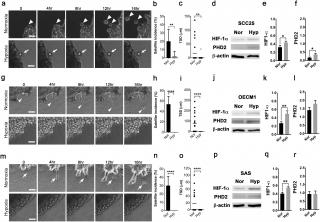Jun, 2022

Dissemination is an ominous feature of cancer to cause poor prognosis. Formation of tumor satellites is the first step, which is closely interdependent on the factors originating from surrounding niche. Because of lacking appropriate modeling, most studies focusing on cancer-environmental interaction depend on the static pathological analyses of specimens. Using the biomimicking system capable of inducing tumor satellite formation in vitro, the niche factors were explored for their influence on cancer budding. Our results demonstrated the real-time dynamic of tumor satellite formation of head and neck squamous cell carcinoma (HNSCC) that was significantly affected by these niche factors. Hypoxia reduced the incidence and migratory distance of HNSCC tumor satellites via decreasing the nuclear localization of intracellular domain of E-cadherin (iEcad) and β-catenin. Three-dimensional (3D) architecture and collagen were essential for mediating hypoxia effects on nuclear translocation and signaling transduction of iEcad and β-catenin in the HNSCC cells. The findings were further confirmed by the compatible in vivo findings of the cancer specimens. This approach revealed the effects of oxygen and extracellular matrices on tumor satellites. The cellular behaviors and molecular dynamics were along a phenotypic spectrum that conferred unique change for specific cancer populations in response to the altered microenvironment. The current study provides a platform to recapitulate the process of cancer budding, and a way to investigate the mutual interaction between the cancer cells and their surrounding microenvironment.